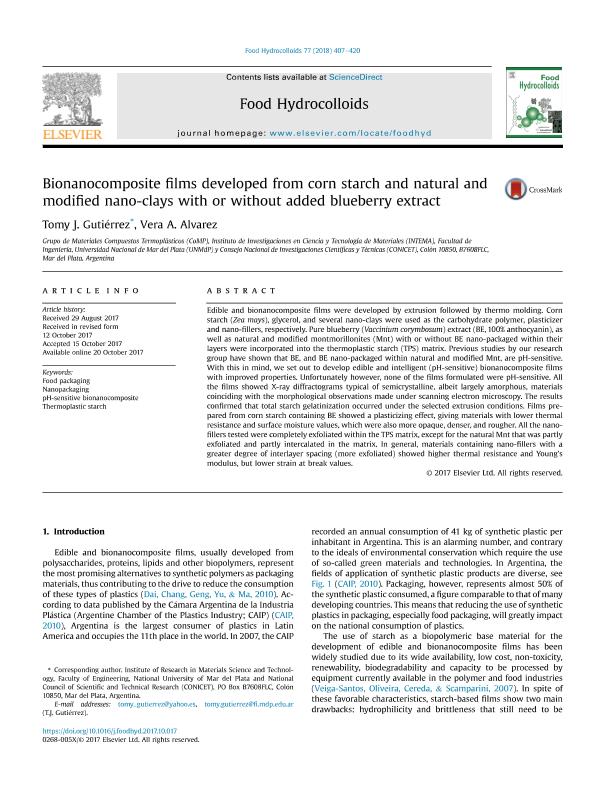Mostrar el registro sencillo del ítem
dc.contributor.author
Gutiérrez Carmona, Tomy José

dc.contributor.author
Alvarez, Vera Alejandra

dc.date.available
2019-12-05T19:13:55Z
dc.date.issued
2018-04
dc.identifier.citation
Gutiérrez Carmona, Tomy José; Alvarez, Vera Alejandra; Bionanocomposite films developed from corn starch and natural and modified nano-clays with or without added blueberry extract; Elsevier; Food Hydrocolloids; 77; 4-2018; 407-420
dc.identifier.issn
0268-005X
dc.identifier.uri
http://hdl.handle.net/11336/91521
dc.description.abstract
Edible and bionanocomposite films were developed by extrusion followed by thermo molding. Corn starch (Zea mays), glycerol, and several nano-clays were used as the carbohydrate polymer, plasticizer and nano-fillers, respectively. Pure blueberry (Vaccinium corymbosum) extract (BE, 100% anthocyanin), as well as natural and modified montmorillonites (Mnt) with or without BE nano-packaged within their layers were incorporated into the thermoplastic starch (TPS) matrix. Previous studies by our research group have shown that BE, and BE nano-packaged within natural and modified Mnt, are pH-sensitive. With this in mind, we set out to develop edible and intelligent (pH-sensitive) bionanocomposite films with improved properties. Unfortunately however, none of the films formulated were pH-sensitive. All the films showed X-ray diffractograms typical of semicrystalline, albeit largely amorphous, materials coinciding with the morphological observations made under scanning electron microscopy. The results confirmed that total starch gelatinization occurred under the selected extrusion conditions. Films prepared from corn starch containing BE showed a plasticizing effect, giving materials with lower thermal resistance and surface moisture values, which were also more opaque, denser, and rougher. All the nano-fillers tested were completely exfoliated within the TPS matrix, except for the natural Mnt that was partly exfoliated and partly intercalated in the matrix. In general, materials containing nano-fillers with a greater degree of interlayer spacing (more exfoliated) showed higher thermal resistance and Young's modulus, but lower strain at break values.
dc.format
application/pdf
dc.language.iso
eng
dc.publisher
Elsevier

dc.rights
info:eu-repo/semantics/openAccess
dc.rights
Atribución-NoComercial-CompartirIgual 2.5 Argentina (CC BY-NC-SA 2.5 AR)
dc.rights.uri
https://creativecommons.org/licenses/by-nc-nd/2.5/ar/
dc.subject
FOOD PACKAGING
dc.subject
NANOPACKAGING
dc.subject
PH-SENSITIVE BIONANOCOMPOSITE
dc.subject
THERMOPLASTIC STARCH
dc.subject.classification
Alimentos y Bebidas

dc.subject.classification
Otras Ingenierías y Tecnologías

dc.subject.classification
INGENIERÍAS Y TECNOLOGÍAS

dc.subject.classification
Recubrimientos y Películas

dc.subject.classification
Ingeniería de los Materiales

dc.subject.classification
INGENIERÍAS Y TECNOLOGÍAS

dc.title
Bionanocomposite films developed from corn starch and natural and modified nano-clays with or without added blueberry extract
dc.type
info:eu-repo/semantics/article
dc.type
info:ar-repo/semantics/artículo
dc.type
info:eu-repo/semantics/publishedVersion
dc.date.updated
2019-10-22T15:39:26Z
dc.journal.volume
77
dc.journal.pagination
407-420
dc.journal.pais
Países Bajos

dc.journal.ciudad
Amsterdam
dc.description.fil
Fil: Gutiérrez Carmona, Tomy José. Consejo Nacional de Investigaciones Científicas y Técnicas. Centro Científico Tecnológico Conicet - Mar del Plata. Instituto de Investigaciones en Ciencia y Tecnología de Materiales. Universidad Nacional de Mar del Plata. Facultad de Ingeniería. Instituto de Investigaciones en Ciencia y Tecnología de Materiales; Argentina
dc.description.fil
Fil: Alvarez, Vera Alejandra. Consejo Nacional de Investigaciones Científicas y Técnicas. Centro Científico Tecnológico Conicet - Mar del Plata. Instituto de Investigaciones en Ciencia y Tecnología de Materiales. Universidad Nacional de Mar del Plata. Facultad de Ingeniería. Instituto de Investigaciones en Ciencia y Tecnología de Materiales; Argentina
dc.journal.title
Food Hydrocolloids

dc.relation.alternativeid
info:eu-repo/semantics/altIdentifier/url/https://www.sciencedirect.com/science/article/pii/S0268005X17314753
dc.relation.alternativeid
info:eu-repo/semantics/altIdentifier/doi/http://dx.doi.org/10.1016/j.foodhyd.2017.10.017
Archivos asociados
